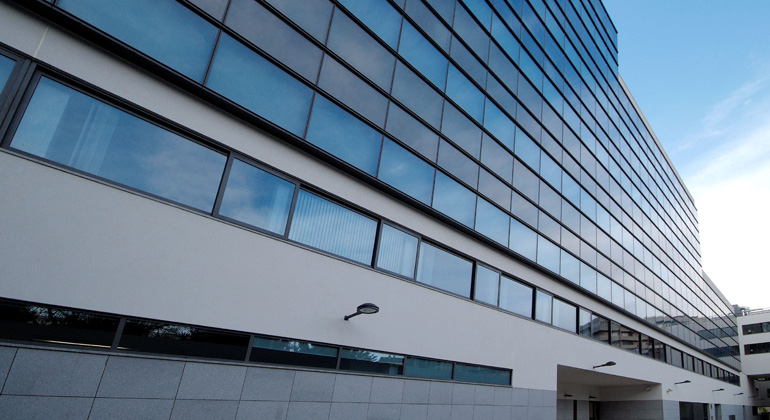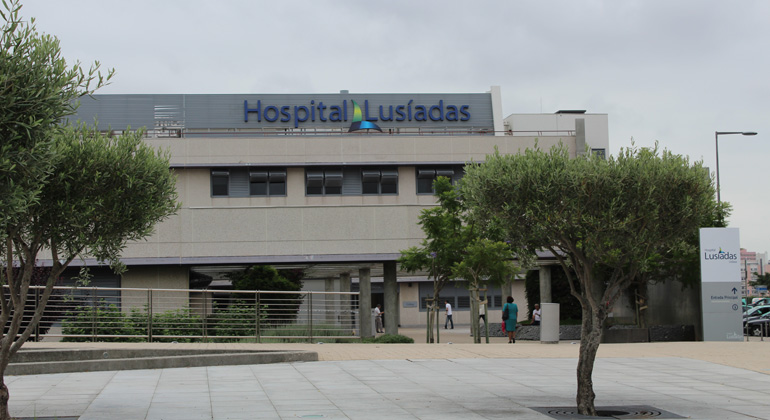LASIK (Laser Eye Surgery)
LASIK stands for laser in situ keratomileusis, which means using a laser underneath a corneal flap (in situ) to reshape the cornea (keratomileusis) in order to treat refractive errors, improve vision, and reduce or eliminate the need for glasses or contact lenses
This procedure utilizes a highly specialized laser (excimer laser) designed to treat refractive errors, improve vision, and reduce or eliminate the need for glasses or contact lenses. This laser procedure alters the shape of the cornea, which is the transparent front covering of the eye. Though the excimer laser had been used for many years before, the development of LASIK is generally credited to Ioannis Pallikaris from Greece around 1991.
If you would like to learn more information about LASIK in Portugal, contact us through email, by calling +351 220 973 751, +351 211 379 718, +351 911 046 197, or by filling out our form. You can also contact us through our free call service to your right.
During the LASIK procedure, a specially trained eye surgeon first creates a precise, thin hinged corneal flap using a microkeratome. The surgeon then pulls back the flap to expose the underlying corneal tissue, and then the excimer laser ablates (reshapes) the cornea in a unique pre-specified pattern for each patient. The flap is then gently repositioned onto the underlying cornea without sutures.
In the human eye, the front surface (cornea) and lens inside the eye form the eye's "focusing system" and are primarily responsible for focusing incoming light rays onto the surface of the retina, much like the lenses of a camera focus light onto the film. In a perfect optical system, the power of the cornea and lens are perfectly matched with the length of the eye and images are in focus; any mismatch in this system is called a refractive error, and the result is a blurred image at some location. The primary types are Myopia, Hyperopia and Astigmatism.
There are a variety of different types of lasers used in ophthalmology. All LASIK procedures are performed with a specific type of laser (excimer laser), so in one sense, all LASIK procedures are similar. However, there are a variety of different laser manufacturers, including Visx, Wavelight, Alcon, Bausch & Lomb, and Nidek, among others, that have all designed specific excimer lasers. Further, there are different types of laser ablations that can be performed (see below), including conventional laser treatments, wavefront-optimized treatments, and wavefront-guided treatments. Finally, a completely different type of laser (femtosecond laser) can be used instead of a mechanical microkeratome to create the LASIK (corneal) flap.
LASIK has been shown to be a very effective procedure, and most patients are very happy with their vision following the procedure. However, like any surgical procedure, LASIK does come with some risks. In order for you to decide whether LASIK surgery is right for you, you need to be aware of potential risks and complications and weigh these carefully before proceeding with surgery.
What you should expect before, during, and after surgery may vary slightly from patient to patient and from surgeon to surgeon; however, the information listed below is a general guideline for the LASIK process. Each patient may also have slightly different expectations, and it is important to talk to your eye doctor about these expectations before surgery.
BEFORE SURGERY
Prior to any procedure, you will need a full eye examination by your eye doctor. This process will help determine if you are a good candidate for surgery and whether you have certain risk factors listed above. If you wear contact lenses, you should take them out for many days before your initial examination and use your glasses full-time. This is important because contact lenses will change the shape of your cornea, and if your cornea has not had enough time without the contact lenses, then the measurements taken before surgery may be inaccurate. You should discuss the amount of time you are required to be out of your contact lenses with the surgical center performing your evaluation.
During your initial examination, you should talk to your eye doctor about your past and present medical and eye conditions, including any previous eye surgery or trauma. It is also important to discuss all medicines you are taking, including over the counter medicines, as these can sometimes affect your vision or surgery. Also be sure to mention any medication allergies you have.
During this eye exam, your doctor should discuss certain topics with you, including whether you are a good candidate for refractive surgery. He or she should discuss the risks, benefits, and alternatives of the surgery, and what you should expect before, during, and after the procedure. Your doctor should also explain what will be expected from you before, during, and following the surgery.
It is quite important that you ask questions during this examination, and ideally you should already have the questions you want answered in mind before your examination. You will need to think about all of the risks and benefits and take time to review handouts that are provided to you by your doctor. After you have had plenty of time to think about these issues and had all of your questions answered, you will need to sign an informed consent form. It is not recommended to have your initial evaluation and surgery performed on the same day, as this does not give you enough time to fully contemplate your decision. It is also not ideal to first meet your surgeon on the day of surgery, because this again does not give you ample time and opportunity to ask the questions only your surgeon can answer before your procedure.
On the day of the surgery, you will need to avoid using all lotions, creams, makeup, and perfumes. Some of these items build up on the eyelashes and may increase your risk of infection, while others (lotions and perfumes) can affect the function of the laser. In an effort to clean your eyelid margin, your doctor may ask that you scrub your eyelids and lashes with a gentle soap that is safe for the eyes prior to surgery.
You will also need to arrange for transportation to and from the surgery center both on the day of surgery and for your first follow-up visit the following day. You will not be allowed to drive yourself home after surgery under any circumstances.
DURING SURGERY
LASIK eye surgery normally takes less than 30 minutes to perform surgery on both eyes. You will be taken to the surgical suite and placed into a reclining chair or bed where you will lie on your back. The laser system consists of a microscope that is attached to a large machine and a computer screen.
After you are lying down and have been positioned underneath the laser, numbing eye drops will be placed in your eyes, and the area around your eyes will be cleaned thoroughly. After your surgical team, including your surgeons and assistants, have reviewed and confirmed all of your treatment information, a lid speculum will be placed to keep your eyelids open during the surgery. When it is time to create the LASIK flap, a suction device will be placed on your eye that will fixate it. During this period, you may feel pressure that may be somewhat uncomfortable, and your vision will go dark for a brief period of time. Your doctor will then use the microkeratome to create the corneal flap. After the flap has been created, the microkeratome will be removed, the suction will be off, and your vision will return, although it will likely remain blurry for the remainder of the procedure.
Your doctor will then carefully move the flap in order to expose the underlying corneal tissue. Any excess moisture on the tissue will be dried, and your underlying corneal thickness will be measured. The laser apparatus will then be positioned over your eye. Your doctor will ask you to stare directly at the light. It should be noted that the light you are staring at is not the laser that is being used for the surgery and may have different colors based on the specific laser being used for your treatment. This light is simply used so that your eye will remain in a fixed position.
The laser will be started by your doctor once your eye is in a satisfactory position. Do not be alarmed if you notice ticking sounds and new smells during this part of the procedure. The ticking sound is the sound of the laser pulses and the smell, which has been described by some as that of burning hair, is the evaporation of fluid from your cornea during laser ablation. The amount of laser treatment time varies among patients but is usually less than 60 seconds. After the appropriate amount of corneal tissue has been ablated by the laser, the corneal flap is gently placed back down into its original position.
To protect your eye, a shield will be placed around your eye. This is to prevent you from accidentally rubbing your eye or putting any pressure onto your eye. Your cornea is especially vulnerable in this early postoperative period, which is why it is very important to keep your eye protected. If you are having both eyes treated during the same surgery, the surgeon will reposition the laser over your other eye and the same process will be repeated for the second eye.
AFTER SURGERY
As soon as the procedure is finished, you may notice that your eyes feel irritated, burn, itch, or feel like there is something in them. Your eyes will frequently water or tear excessively, and your vision will be somewhat blurry. The most important thing to avoid during this time is rubbing your eyes. Do not rub your eyes under any circumstances, as rubbing can dislocate or shift the corneal flap, which could require you to have an additional procedure to reposition it. Using copious artificial tears and resting with your eyes closed will most effectively ease these sensations. In some instances, there may be increased discomfort or even a mild degree of pain, for which your doctor may advise you to take a pain reliever. In most cases, nonsteroidal anti-inflammatory drugs, such as ibuprofen, are enough to relieve the pain. In addition to artificial tears, you will have antibiotic drops and anti-inflammatory drops (steroids) to use beginning on the day of surgery that you will continue to use for days to weeks after surgery.
Other symptoms you may notice immediately after surgery include light sensitivity, hazy vision, glare, seeing starbursts or halos around lights, and reddened or bloodshot eyes. All of these symptoms should improve over the first few days following surgery. It is very important that you contact your doctor immediately on the first night after surgery if you are having severe pain or if your vision is getting worse and not better. You do not need to wait until your first follow-up visit if you are experiencing either of these things.
Your first postoperative visit should be scheduled within the first 24 hours following surgery. At that visit, your doctor will check your vision and examine your eyes. You will continue to use your antibiotics and steroid drops as well as artificial tears. Your vision should be clearer but may still be blurry the first few days after surgery, and you may need to adjust your work or travel schedule or even take some time off after surgery to fully recuperate.
You should ask your doctor how long you need to wait to start participating in sports again, such as walking or jogging. In general, you should wait anywhere from one to three days following surgery to restart low impact sports, and avoid any possible eye trauma, such as more competitive sports, for a minimum of two or more weeks. In addition, it is unwise to expose yourself to eye infection risks such as pools, lakes, or hot tubs during the early healing process. Your surgeon will tell you when you can resume these activities.
As mentioned earlier, lotions, creams, makeup, and perfumes can often cause buildup on the eyelids and may increase the risk for infection. Ask your doctor when it is advisable to resume use of these products.
Typically, your vision will stabilize within the first week or two, but it may continue to change over the first couple of months following surgery. It may take anywhere from three to six months for your vision to stabilize completely. Other visual symptoms, such as glare, seeing halos, and difficulty driving at night, may continue during this stabilization period. Additional treatments, or enhancements, may be needed after surgery, but the stability of your cornea will need to be established before any repeat treatments are performed. Before enhancements are considered, you should have had consistent eye measurements at two consecutive visits. When considering additional treatments, you should know that while it is likely that your vision can be improved by enhancements, just as with the initial surgery, there are no guarantees, and there are still risks associated with having surgery.
You should not hesitate to call your eye doctor immediately if you develop worsening or unusual symptoms at any time after surgery. These symptoms could be a sign of a serious problem that could result in loss of vision if not treated properly in a timely fashion.
In summary, despite the risks outlined above, LASIK has been proven to be safe and effective for most people. With careful patient screening and selection, reasonable expectations, and in the care of an experienced surgeon, most patients will be very pleased with their results. These are some of the other advantages of LASIK:
- LASIK is able to accurately correct most levels of myopia (nearsightedness), hyperopia (farsightedness), and astigmatism;
- The procedure is fast, usually lasting only five to 10 minutes, and is generally painless;
- Because the laser is guided by a computer, it is very precise and results are very accurate;
- In most cases, a single treatment will achieve the desired outcome; however, enhancements are possible if needed, even many years after the initial surgery.
Doctors who perform this medical procedure

Ophthalmology
With a degree in Medicine by Faculdade de Medicina do Porto, and a Specialists' Degree in Ophthalmology by Ordem dos Médicos, Dr. Rui Martinho was a Fellow of the European Board and is the Coordinator of the Ophthalmology Service at Hospital Lusíadas Porto (located at Boavista avenue) since 1998.
Member of the Portuguese Society of Ophthalmology, the American Academy of Ophthalmology and the European Society of Cataract and Refractive Surgery.
Areas of interest: Surgical Retina, Refractive Surgery (LASIK), Cataracts, Laser

Ophthalmologist at Hospital Lusíadas Porto
With a degree in Medicine, and an Ophthalmology Specialist, Dr. Jorge Palmares works with Hospital Lusíadas Porto (located at Boavista Avenue) since 1998. Coordinator for the Portuguese Group of Inflammation, Member of the Establishment Commission of the Ophthalmologys' College of Ordem dos Médicos and Country Liaison - Tear Film & Ocular Surface Society, was a Member of the Ophthalmologys' College's Board.
Main areas of interest: Eye inflammation, Ocular surface diseases, Cornea and Cataracts surgeries.


